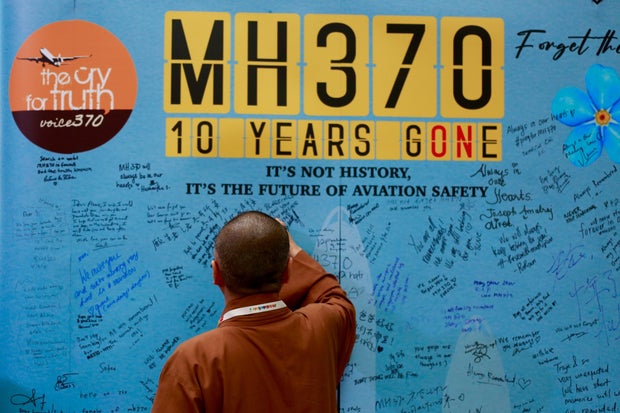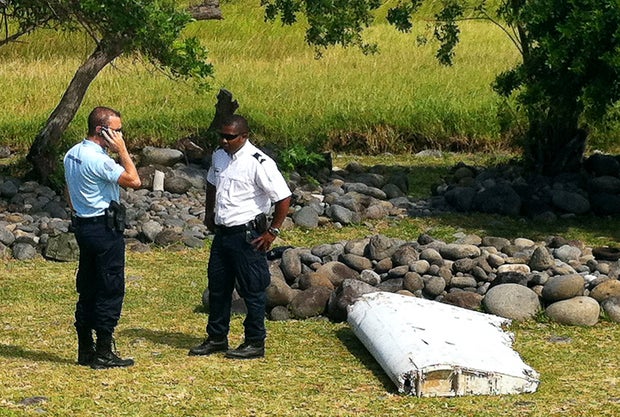CBS News
60 Minutes witnesses international incident in the South China Sea

For this week’s season premiere of 60 Minutes, correspondent Cecilia Vega and a producing team intended to report on tensions between China and the Philippines in the South China Sea. They did not expect to end up in the middle of an international incident themselves, seeing China’s intimidation tactics first-hand.
The plan was for the 60 Minutes team to accompany the Philippine Coast Guard on a routine mission to resupply its ships and stations. Vega and team boarded the Cape Engaño, a Philippine Coast Guard ship, around 8 p.m. and prepared for their trip to Sabina Shoal, an atoll that lies 93 miles west of the Philippine province of Palawan.
Around 4 a.m. the next day, the 60 Minutes team was woken up by a loud bang, followed by an alarm. A Chinese ship had rammed the Cape Engaño, the Philippine crew informed them, telling them to put on life jackets and stay put inside their cabins.
As 60 Minutes producers Andy Court and Jacqueline Williams assessed the situation, several possible scenarios came to their minds.
“Are we taking on water? Are we going to sink out here in the middle of the South China Sea?” Williams recalls thinking. “I’m seeing Coast Guard personnel standing by the door, guarding the door. So we’re thinking, ‘Are the Chinese about to board our ship?'”
On the advice of veteran 60 Minutes cameraman Don Lee, the crew grabbed their passports and made a plan to secure the footage they had been shooting on board, in the event that Chinese sailors did board the Cape Engaño and attempted to take the cameras’ digital memory cards.
“We had to make sure that when we got off that ship, that we had that footage and we could show the world what it was that we were seeing,” Williams said.
Once back on deck, the 60 Minutes crew saw the three-and-a-half-foot hole torn into the Cape Engaño’s hull. As daylight dawned, they also saw how many Chinese ships surrounded the Philippine ship, bows pointed at it. During the standoff, the crew aboard the Cape Engaño was unable to access internet or cell service, and the Filipinos said it was likely because the Chinese were jamming their communications.
“I’ve been working for this show for a long time,” Court said. “I’ve been in a lot of situations that were dangerous and tense in some way. I don’t think I’ve ever felt this vulnerable. You’re completely isolated out there. You’re completely surrounded.”
As the Filipinos tried to negotiate a way out, they were forced to abandon the first stop on their resupply mission.
The incident was one of many between China and the Philippines during increasing tensions in the last two years. An international tribunal at the Hague in 2016 defined the Philippines’ exclusive economic zone, or EEZ, a 200-mile area that includes Sabina Shoal and the area where the Cape Engaño was rammed. China does not recognize the ruling and continues to claim sovereignty over most of the South China Sea, through which more than $3 trillion worth of global trade passes annually.
Over the past few months, China has rammed Philippine boats, sprayed them with water cannons, and blocked their safe passage within the Philippine EEZ. The incident 60 Minutes witnessed on the Cape Engaño signaled a movement of the conflict closer to the Philippine shore than ever before.
China has blamed the Philippines for the tense events at sea. Within hours of the ramming of the Cape Engaño, the Chinese publicized their own version of events. It was the Filipinos, they said in a published video, who rammed the Chinese Coast Guard ship. The video highlighted the faces of the 60 Minutes crew on deck, accusing them of being used as part of a Philippine propaganda campaign.
“The idea that the Filipinos at 4 in the morning could think of nothing better to do than to ram a much larger Coast Guard vessel, a vessel nearly twice their size, seems a little implausible to me,” 60 Minutes producer Andy Court said.
According to correspondent Cecilia Vega, the 60 Minutes team was there simply to document what they witnessed and to show the world what the Filipinos routinely experience.
“The intimidation is very real when you see it up close,” she said. “What you also see, and it takes going out there to see this for yourself, is just how volatile this situation is.”
The video above was produced by Brit McCandless Farmer and edited by Scott Rosann.
CBS News
Malaysia agrees to launch new search for MH370 plane, which vanished a decade ago with 239 people on board

Malaysia announced on Friday it has agreed to launch a new search for Malaysia Airlines flight MH370, which disappeared 10 years ago in one of aviation’s greatest enduring mysteries.
The Boeing 777 carrying 239 people disappeared from radar screens on March 8, 2014 while en route from Kuala Lumpur to Beijing.
Despite the largest search in aviation history, the plane has never been found. Malaysia’s prime minister said 17 days after the plane disappeared that, based on the satellite data, his government had concluded that the plane crashed down in a remote corner of the Indian Ocean, and that there were no survivors.
Transport Minister Anthony Loke said Malaysia had agreed to a new search operation by maritime exploration firm Ocean Infinity, which also carried out an unsuccessful hunt in 2018.
The company’s first efforts followed a massive Australia-led search for the aircraft that lasted three years before it was suspended in January 2017.
Loke said a new 5,800 square mile area of the southern Indian Ocean would be scoured by Ocean Infinity, which is based in the United Kingdom and United States.
“The new search area proposed by Ocean Infinity is based on the latest information and data analysis conducted by experts and researchers,” Loke said.
“The proposal for a search operation by Ocean Infinity is a solid one and deserves to be considered,” he told reporters.
The government said it agreed to Ocean Infinity’s proposal “in principle” on December 13, with the transport ministry expected to finalize terms by early 2025.
The new search will resume “as soon as the contract is finalized and signed by both parties”, Loke said.
“They have informed us that the ideal time for the search in the designated waters is between January and April. We are working to finalise the agreement as quickly as possible,” he added.
“I truly hope there will be an end to the loss of MH370. May all questions be answered,” Malaysian Rosila Abu Samah, 60, the stepmother of one of the passengers, told AFP.
Supian Ahmad/NurPhoto/Getty
Malaysian Shim Kok Chau, 49, whose wife was a flight attendant on the ill-fated flight, said he had come to accept her fate but hopes to know what happened to the plane, “why it happened and who did it.”
Among the other victims was a celebrated group of 24 Chinese calligraphy artists coming from an exhibition of their work. Two young Iranian men on the plane, 18-year-old Pouria Nour Mohammad Mehrdad and 29-year-old Delavar Seyed Mohammadreza, were traveling on stolen passports to seek better lives in Europe.
Two of the U.S. citizens on the plane were young children, Nicole Meng, 4, and 2-year-old Yan Zhang.
Philip Wood was the only American adult on the flight. The IBM executive had been living in Beijing and was planning to relocate to the Malaysian capital with his girlfriend, Sarah Bajc.
“No find, no fee”
The new search will be on the same “no find, no fee” principle as Ocean Infinity’s previous search, with the government only paying out if they find the aircraft.
The contract is for 18 months and Malaysia will pay $70 million to the company if the plane is found, Loke said.
He said the decision to agree to a fresh search “reflects the Malaysian government’s commitment to continuing the search operation and providing closure to the families of the MH370 victims.”
The original Australia-led search covered 120,000 square kilometers in the Indian Ocean but found hardly any trace of the plane, with only some pieces of debris picked up.
In July 2015, an airplane fragment later confirmed to be a flaperon from MH370 was found washed ashore on the western Indian Ocean island of Reunion. It was the first hard evidence that the plane had gone down in the area. More debris was later found washed up on the coast of eastern Africa.
YANNICK PITOU/AFP/Getty Images
The plane’s disappearance has long been the subject of theories — including that veteran pilot Zaharie Ahmad Shah had gone rogue.
A final report into the tragedy released in 2018 pointed to failings by air traffic control and said the course of the plane was changed manually.
Asked if he was confident the plane will be found during the new search, Loke said: “At this point, no one can provide guarantees.
“It has been over 10 years, and it would be unfair to expect a concrete commitment. However, under the terms and conditions, any discovery must be credible. It cannot just be a few fragments; there are specific criteria outlined in the contract.”
CBS News
News details emerge about Utah mother, 3 young children killed at their home

A Utah mother who police believe was shot and killed by her husband along with three of their children was a refugee who fled violence in Myanmar and dreamed of thriving with her family in the U.S., relatives said Thursday.
Police believe the husband killed his family before shooting himself, and a teenage son was badly wounded.
The bodies of Bu Meh, 38, along with her daughters Kristina Ree, 8, and Nyay Meh, 2, and son Boe Reh, 11, were found in their home in West Valley City, a Salt Lake City suburb, on Tuesday. A handgun was found under the father Dae Reh, 42, leading police to believe this was a murder-suicide, but no evidence of a motive has been released.
One child, 17-year-old Sha Reh, survived being shot in the head and is hospitalized with a severe brain injury, police said.
Bu Meh, a member of Myanmar’s Karenni ethnic minority, fled what her relatives described as ethnic cleansing in the Southeast Asian nation about 10 years ago. She and her small family lived for a time in a refugee camp in Thailand, then came to the United States “with little more than the clothing on their backs,” the family said in a statement.
She taught herself English, learned new skills and worked hard to support her growing family, achieving a way of life “far beyond the nightmare of her former country or the refugee camp,” the family said.
“For reasons that we cannot comprehend, her husband robbed her and their children of that security and their very lives,” her family said.
Police believe the shooting happened over the weekend.
Police initially went to the home Monday night after a relative asked them to check on the family but did not find any sign of an emergency that would allow them to enter the home. The relative went to the home Tuesday, saw Sha Reh wounded in the garage and called police, who found the bodies inside the home.
In their statement, relatives called Sha Reh their hero and said he faces a “long and complex road to recovery.” An online fundraiser is collecting donations to pay for his care and to help him go to college.
“After moving into their own home and finally enjoying a level of prosperity far beyond the nightmare of their former country or the refugee camp in Thailand in which they lived for a season, and for reasons that we cannot comprehend,” the family wrote, “her husband robbed her and their children of that security and their very lives.”
Neighbors hadn’t reported any gunshots in the area over the weekend, police spokesperson Roxeanne Vainuku said at a news conference Wednesday. The family had no previous reports of domestic violence or other disturbances.
One neighbor spoke to CBS affiliate KUTV about the shock they felt.
“How can a father shoot his children?” neighbor Mike Webster told the station. “I just can’t grasp for that concept at all. I can just see that poor little two-year-old looking at her daddy.”
This Utah case is the 38th mass killing in the United States this year. At least 165 people have died this year in U.S. mass killings, which are defined by the FBI as cases in which four or more people die within a 24-hour period, not including the killer.
Mark Barden, whose child was killed in the 2012 Sandy Hook school shooting, urged Utah lawmakers to pass Red Flag laws after the incident in Utah, KUTV reported.
“When it is recognized that an individual is in crisis, measures to safely and temporarily remove firearms from their possession are proven to save lives,” Barden said.
CBS News
Two journalists killed in northern Syria

A journalists’ association says two journalists working for Kurdish media outlets were killed in northern Syria while covering fighting between Turkish-backed fighters and Syrian Kurdish militia.
The Turkey-based Dicle-Firat Journalists Association said Friday that Nazim Dastan and Cihan Bilgin were killed Thursday when their vehicle was reportedly targeted by a Turkish drone on a road near the Tishrin Dam.
Tishrin Dam, located some 56 miles east of Aleppo, has been the scene of clashes between the U.S.-backed Syrian Democratic Forces, SDF, and the Turkey-backed opposition forces.
There was no immediate comment from Turkish officials.
Bianet, a news website dedicated to human rights issues, said Bilgin was a reporter for the Kurdish Hawar News Agency, while Dastan worked as a freelance journalist for the Firat News Agency, which is associated with the militant group, the Kurdistan Workers’ Party (PKK).
Turkey considers the SDF a terrorist organization because its main component is a group aligned to the PKK.
The group has been engaged in an armed struggle against the Turkish state since the 1980s in pursuit of its objective of securing autonomy for Kurds in the country.









